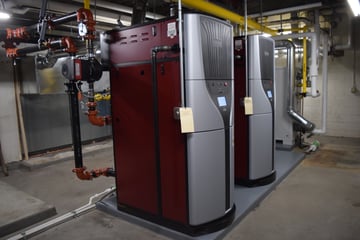With the surge of high efficiency condensing boilers comes the responsibility of water quality: internally and externally. Water quality, along with specific boiler preventive maintenance, is paramount in ensuring the health of a condensing boiler regardless of heat exchanger material. As an owner, operator or engineer everyone must be cognizant of a system’s needs.
Unfortunately there is a stigmatism that if a hydronic system is operating on natural gas then system maintenance and water treatment is unnecessary. That assumption could render premature boiler failure during the coldest winter day.
Condensing boilers have changed the way we provide heat to our homes, apartment buildings and even large commercial/industrial facilities. Regardless of its application, all condensing boilers  are supposed to condense thus the name. That doesn’t always occur but that is a topic for another time! When boiler return water temperature drops below 135°F (dew point) and the supply vs. return water temperature is greater than 20°F condensing occurs, thus water will exit the bottom of the boiler’s flue collector and into a building drain. Unfortunately, condensate is extremely acidic and contains a PH level between 3 and 5 (think orange juice). Pouring any type of acidic product down a drain is quite corrosive and the piping will deteriorate over time.
are supposed to condense thus the name. That doesn’t always occur but that is a topic for another time! When boiler return water temperature drops below 135°F (dew point) and the supply vs. return water temperature is greater than 20°F condensing occurs, thus water will exit the bottom of the boiler’s flue collector and into a building drain. Unfortunately, condensate is extremely acidic and contains a PH level between 3 and 5 (think orange juice). Pouring any type of acidic product down a drain is quite corrosive and the piping will deteriorate over time.
In order to mitigate the acidity, a condensate neutralizing tank must be installed in the condensate line prior to entering the drain. These condensate neutralizers are relatively inexpensive as they are constructed of PVC and lime chips. The lime acts as the agent which brings the PH back up to a neutral level (7). Please note the lime must be inspected a few times a year and will need replacement.
On the flip side of external water quality and even more critical is internal water condition. A condensing boiler can and will fail prematurely without the necessary precautions taken from appropriate water treatment. Whether it’s hard water which causes scaling or soft water which is corrosive, it must be checked periodically. It doesn’t stop at hard or soft water either!
Within a heating system are a lot of dissimilar metals. Ferrous metals wouldn’t harm a cast iron boiler system but in a condensing boiler it is toxic and the reason for an early demise. Dissimilar metals create iron oxide (turns into sludge) which finds its way into the base of the boiler and is extremely difficult to remove. This decreases the boilers overall efficiency as it must work harder to overcome the built up sediment.
Condensing boiler passages are quite small thus it doesn’t take long to collect and eventually harden. It’s not just the boilers that are failing due to poor water but also circulator pumps, seals and zone valves which are getting hung up. As we enter into a time period where some of the original condensing boilers are starting to fail, it behooves your organization from not performing system water quality tests. Contact us today to assist with your water quality needs.
Tip: Drain some boiler water into a peanut butter jar and let it sit for a day. Then grab an extremely strong magnet and drag it against the jar base. If the water is clear then you are free of iron oxides but if it’s a bit dark and the black pieces follow the magnet then you know that water treatment is needed.


